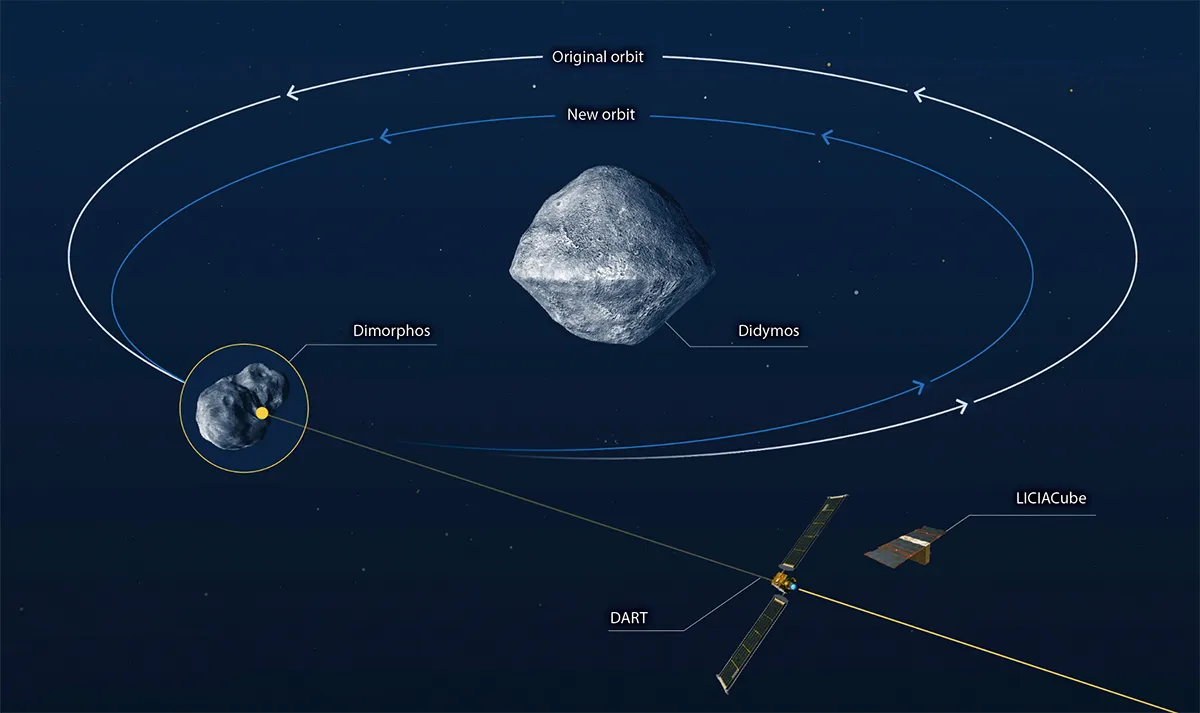This evening, 26 September at 19:14 EDT (23:14 UTC), NASA’s DART mission will purposely crash into the asteroid Dimorphos. Its aim is to find out if deflection could save Earth from future impacts.
The DART (Double Asteroid Redirection Test) mission is a very exciting first step for planetary defence.
It’s a NASA mission that’s built and managed by the Johns Hopkins Applied Physics Lab that is purposely crashing a spacecraft into an asteroid to change its motion slightly.
Where to watch the NASA DART mission online
You can live stream DART's impact event tonight via NASA TV in the window below:
Or if you just want to watch the DRACO feed with no commentary, you can find that here.
The purpose of the DART mission
DART is just one part of a much larger planetary defence strategy. Key to that strategy is finding asteroids ahead of time.
If one was ever discovered to be on course with Earth, this method could potentially deflect it.
We’re not blowing up the asteroid. Rather, we give it a small nudge, which changes its orbit ever so slightly.
When you do this years in advance, it adds up over time so that the asteroid and Earth aren’t on a collision course in the future.
It’s important to say that the Dimorphus asteroid is not a threat to Earth: this is just a test. But it’s an important first step.
Which asteroid will DART impact?

DART's target is actually a double asteroid. The largest one is named Didymos and has a moon that orbits around it, Dimorphos.
DART is targeting that small moon. It’s just going to change how it goes around the much larger asteroid ever so slightly.
The fact that it’s a double asteroid is key to enabling the mission. We want to know how much we deflected the asteroid, but the spacecraft will be totally destroyed.
Instead, we’ll use telescopes here on Earth. These have already been studying this double asteroid system for decades.
We know it takes 11 hours and 55 minutes for Dimorphos to go around Didymos right now.
We’re going to turn back to those telescopes after the impact and they’ll tell us how much we changed the orbit time.
It’s going to be small, maybe about a 1% change, which may be about 10 minutes or so.
What will we see during the impact?
DART is a really focused mission, but it has a camera named DRACO (Didymos Reconnaissance Asteroid Camera for Optical Navigation).
It has two purposes.
First is to see the asteroid. This asteroid is 160m in diameter and we’re targeting it very fast – 22,500km/h.
In fact, because Dimorphos is so close to Didymos, you can’t actually distinguish them until the last hour of the mission.
So DART has to autonomously detect Dimorphos, fire its thrusters and use those DRACO images to ensure an effective collision.
The second purpose is to stream images back during its final moments.

Will we see DART's impact from Earth?
The telescopes that we’re going to use to make this precise measurement of how much we deflected the asteroid have to be state-of-the-art facilities.
That said, the distance between Didymos and Earth is minimised during impact to around 17.7 million kilometres, so it will be shining at about magnitude +15.0.
If you have a back garden telescope equipped with a CCD camera or other imaging system, you won’t be able to make out Dimorphos or the impact itself, but you might be able to capture an image of where Didymos is in the sky.
I definitely encourage people to give that a try.
We'll also be sharing the whole kinetic impact event live on NASA TV on 26 September, showing those final images from the DRACO camera until they stop.
It’s going to be a historic event we get to witness together.
[At the time of the impact, Dimorphos will be in the constellation of Fornax and best viewed from the southern hemisphere. The asteroid will rise in the UK later in the evening. The star chart below shows its location at 4am on 27 September 2022]

Could DART make the asteroid a threat to Earth?
This is one of the beauties of this mission. We’re just knocking Dimorphos’s orbit ever so slightly closer to the much larger Didymos.
It doesn’t change how that asteroid system goes around the Sun in any measurable manner, and hence there’s no danger to Earth.
I’m excited about the DART mission. We’re taking something from Hollywood blockbusters, asteroid deflection, and making it so we can live in a future where we might have this capability going forward.
And it’s not just fiction, but reality. We’re ready and it’s going to be an exciting year to come.
This article originally appeared in the September 2022 issue of BBC Sky at Night Magazine.

